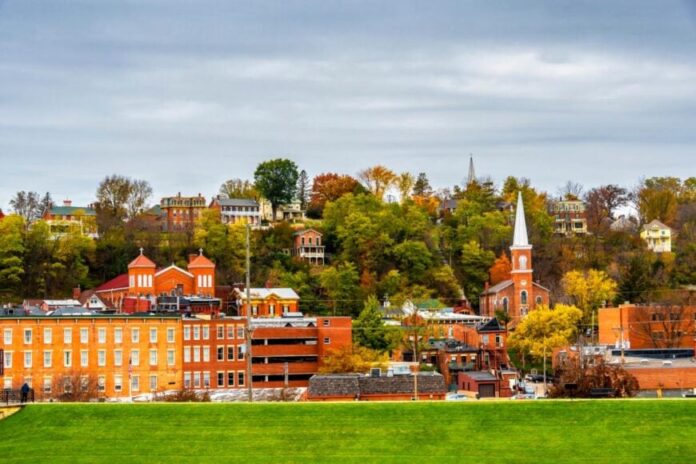Some towns seem to tuck themselves away on purpose—content to stay quiet, rooted, and mostly unchanged. In the southern stretch of Illinois, you’ll find places like that, nestled in river bends, sheltered by forested hills, or resting along backcountry roads.
They don’t clamor for attention; they simply are—steadfast, familiar, and often forgotten. For those drawn to slow mornings, wide skies, and the kind of stillness that settles in your bones, these towns offer something quietly enduring.
25. Fountain Bluff’s River‑Cliff Quiet
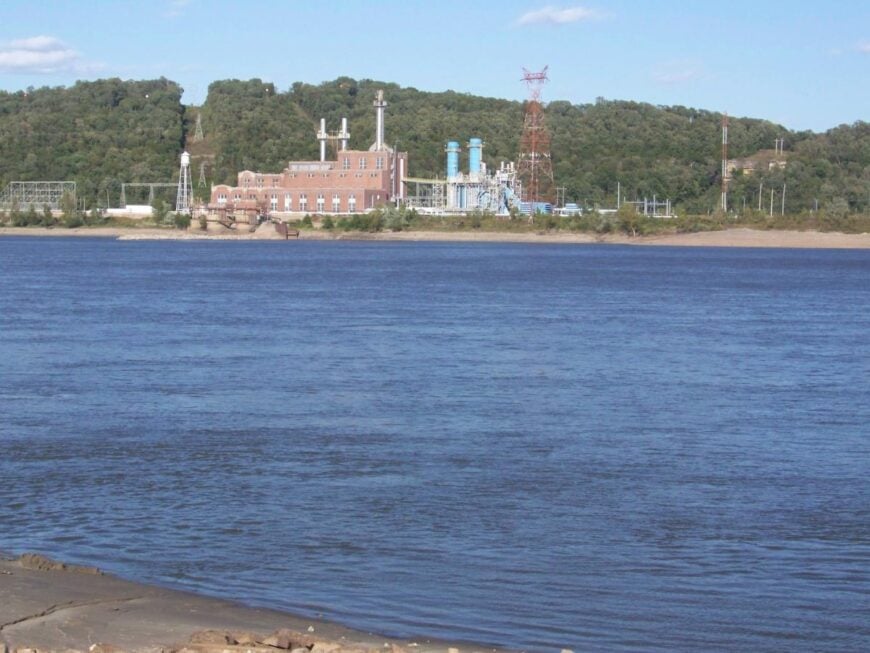
Fountain Bluff lies quietly along the edge of the Mississippi River in southern Illinois, where towering limestone bluffs rise suddenly from the flat floodplain, creating a natural wall between the town and the rest of the world. With no direct highway access and a landscape shaped by water, rock, and forest, it feels completely hidden—hemmed in by the elements and time itself.
The area holds a haunting, almost sacred stillness, where ancient Native American petroglyphs rest on the cliff faces and eagles soar silently above the treetops. You can hike the bluff trails, paddle the backwaters, explore prehistoric rock art, or simply watch the light change over the riverbend.
There are no shops or main streets here—just scattered homes, winding dirt roads, and the sound of birds in the trees. Those who live nearby often farm or work in nearby river towns, but come home to the solitude Fountain Bluff protects. It’s the kind of place that reminds you how the land can choose what it wants to keep hidden.
Where is Fountain Bluff?
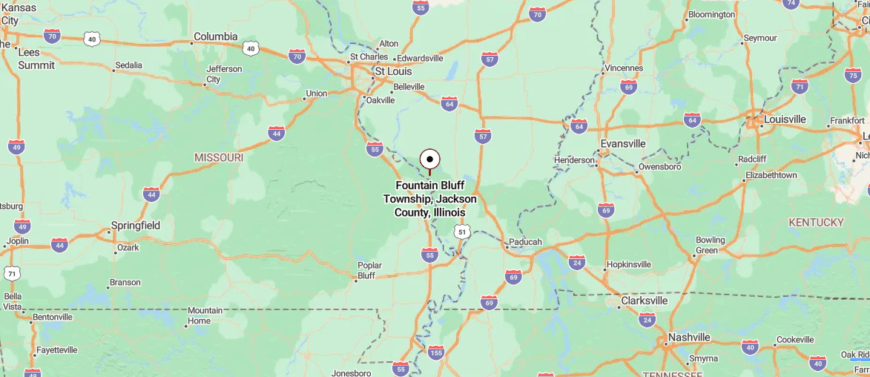
Fountain Bluff rises in Jackson County, tucked into the western edge of Illinois amid the flat floodplain of the Mississippi River yet set apart as a lone, forested ridge often called “Big Hill.” It lies approximately 3 miles south of Gorham and about 11 miles northeast of Grand Tower, along Illinois Route 3 beside the river’s eastern bank.
You reach the bluff by heading off Route 3 onto a narrow rural road that leads south past woodlands and spring‑fed draws before hiking or climbing into its cliff‑lined heights. It’s close enough to drive to easily, but remote enough that its sandstone cliffs, hidden springs, and ancient carvings feel like a quiet refuge where even time seems to pause.
24. Mill Shoals’ Prairie‑Framed Stillness
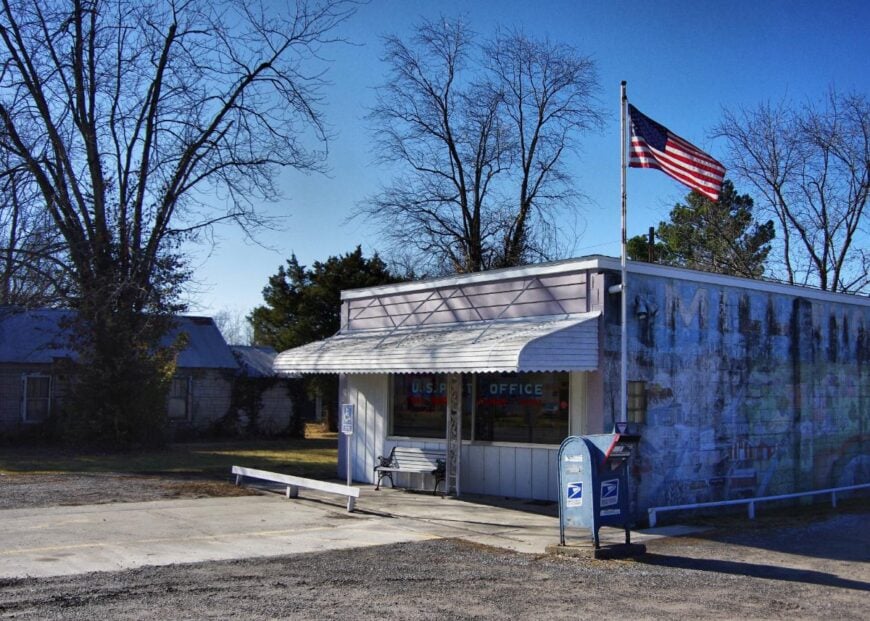
Mill Shoals is a tiny village tucked into the flatlands of southeastern Illinois, where fields stretch unbroken to the horizon and narrow country roads carry more silence than traffic. With fewer than 200 residents and no major highways nearby, the town feels like it’s quietly folded into the landscape.
There’s a stillness here, where weathered barns lean gently with age and porch swings creak in the breeze like clockwork. You can visit the remnants of the old grist mill site, walk along Shoal Creek’s grassy banks, explore local cemeteries that whisper of pioneer days, or take a slow drive through farmland dusted with wildflowers.
Most who live here farm or work in nearby towns, returning home each night to still roads and wide views. The pace is unshaken, the quiet unforced. It’s the kind of place that reminds you how some towns vanish beautifully into the land that made them.
Where is Mill Shoals?
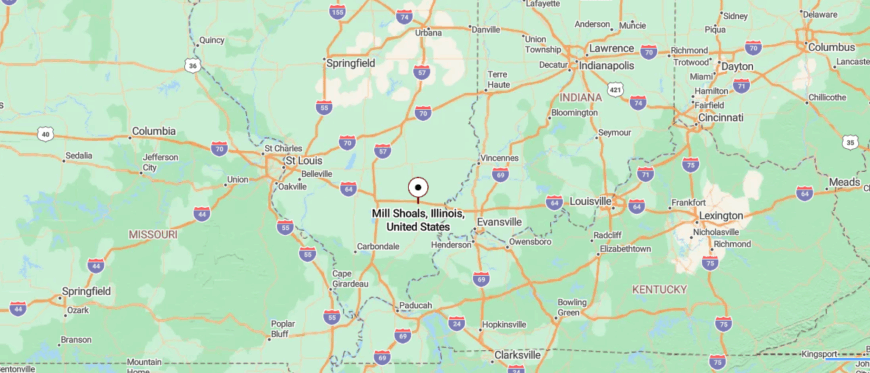
Mill Shoals is located in White County, tucked into southeastern Illinois along the lower stretch of the Wabash River where gentle bottomlands give way to wooded bluffs. It lies roughly 7 miles south of Carmi and about 45 miles west of the Indiana border, quietly set off Illinois Route 1 near the river in a stretch of farmland and forest.
The approach follows two-lane state roads through open pastures and oak-filled ravines before turning onto a quieter rural lane that leads you toward the river and the small village beyond. It’s close enough for a peaceful drive, but secluded enough that the rustle of leaves and the river’s edge seem to usher in a calmer rhythm as you arrive.
23. Carrier Mills’ Tunnel‑Hill Shade
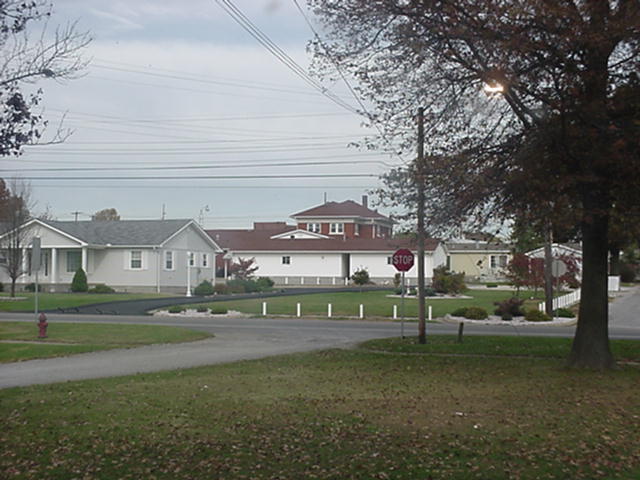
Carrier Mills sits quietly at the edge of the Shawnee National Forest, where thick woods, old mining roads, and the curves of the Saline River help shield it from the world beyond. Removed from major highways and surrounded by forested hills and farmland, the town feels tucked into a forgotten fold of southern Illinois.
There’s a deep-rooted stillness here—remnants of its coal-mining past linger in brick foundations and fading signs, while nature slowly reclaims the edges. Visitors can hike nearby trails in the Shawnee, explore the banks of Lakeview Park, visit the historical society museum, or join locals for the annual Catskin Days festival.
Some residents work in neighboring towns, while others stay close to the land, living quietly in the rhythm of a place that rarely rushes. Carrier Mills feels worn-in, familiar, and wrapped in memory. It’s the kind of place that reminds you how the past still whispers in quiet towns.
Where is Carrier Mills?
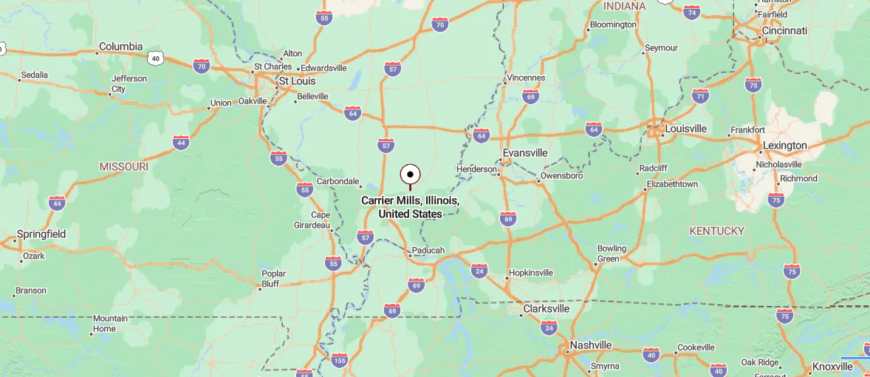
Carrier Mills is located in Saline County, tucked into the rolling river valley of southeast Illinois beside the Saline River and about seven miles southwest of Harrisburg, just off Illinois Route 13. It’s situated roughly 21 miles southwest of Marion and about 36 miles northwest of Carbondale, quietly set amid fields and forested river terraces.
You reach the village via two‑lane highways that pass through farmland and wooded hollows, then turn onto narrow country roads that follow the river’s curves toward town. It’s close enough for a straightforward afternoon drive, yet secluded enough that the rustle of trees and the quiet curve of the river offer a comforting hush as you arrive.
22. Harco’s Quiet Coal Memory
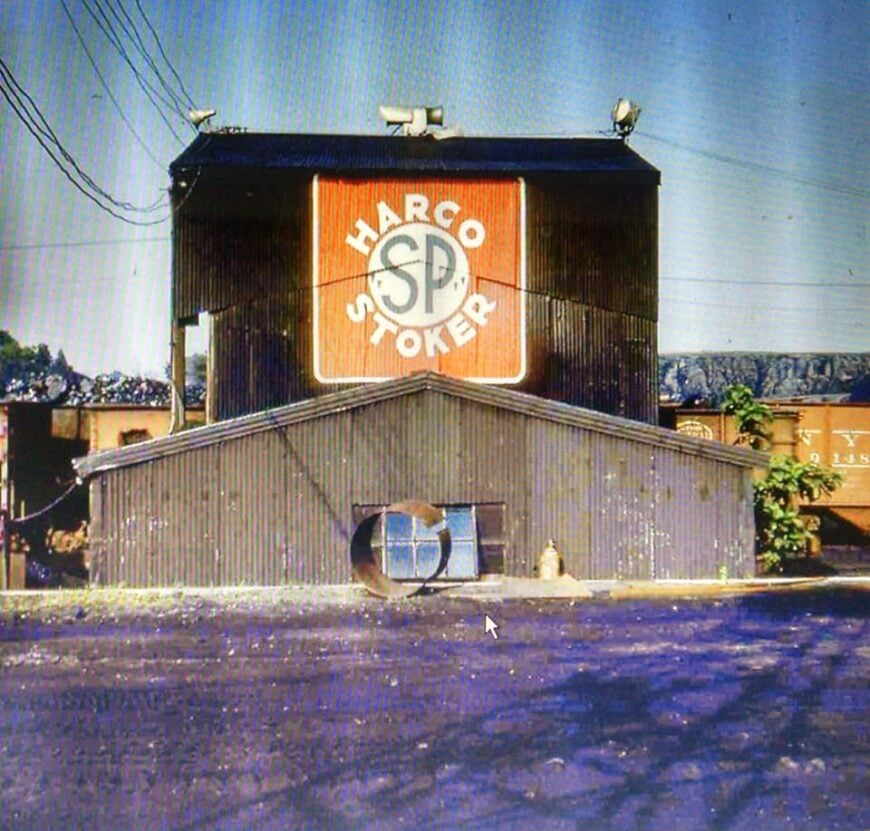
Harco is little more than a name on a map in southern Illinois—tucked between stretches of farmland, forest, and the slow bends of backroads few ever travel. Once a coal town, it now stands quietly in the shadow of its past, with scattered homes, open fields, and a deep rural stillness that makes it feel nearly forgotten.
There are no shops or stoplights here—just the occasional tractor, a rusting mailbox, and the distant bark of a farm dog carried on the wind. Nearby, you can fish along small creeks, explore wooded trails in the Shawnee, or visit old mining sites now softened by nature.
Most locals work in nearby towns or live a self-sufficient life close to the land, surrounded by space and memory. Harco doesn’t announce itself—it just exists quietly, folded into southern Illinois soil. It’s the kind of place that reminds you how solitude can be complete.
Where is Harco?
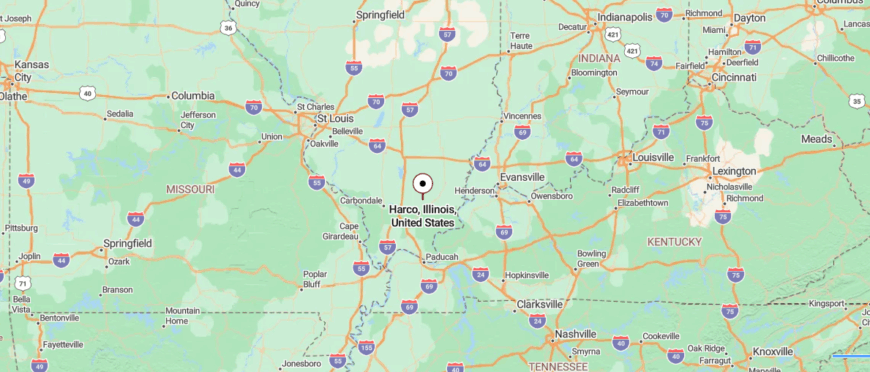
Harco is an unincorporated community in Saline County, tucked into the gently rolling plain of southern Illinois, founded around an early 20th‑century coal mine beside Brushy Creek. It lies about 7 miles west of Harrisburg and just a few miles south of Galatia, quietly set off local county roads in a landscape shaped by former mining terraces and open fields.
You reach it via two‑lane rural highways that weave past pastures, woodlots, and the occasional abandoned mine site before narrowing into country lanes that lead into the small, quiet settlement. It’s close enough to reach on a calm afternoon drive, but secluded enough that the hush of empty fields and the echo of coal‑belt history lend it a timeless stillness.
21. Ledford’s Whispered Past
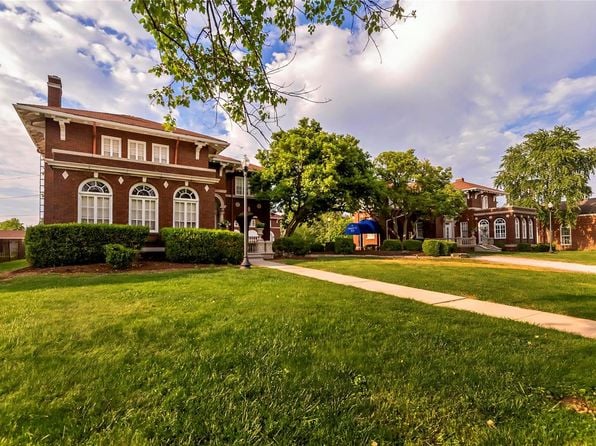
Ledford rests in the quiet hollows of southern Illinois, where coal-mining history and overgrown paths meet under a wide, unhurried sky. Once a bustling mining hub, it’s now a scattered village of quiet homes and fading buildings, tucked away from highways and surrounded by woods, creeks, and fields.
The sense of seclusion here runs deep—abandoned tracks rust beneath weeds, and stories linger in the stillness like dust in sunlight. You might wander down forgotten gravel roads, fish in nearby ponds, explore remnants of the old company store, or walk beneath trees that have reclaimed the edges of what once was.
Most residents now live modestly or commute to larger towns, held by roots that run deep into the land and memory. Ledford feels more like a hush than a town—steady, weathered, and gently fading. It’s the kind of place that reminds you how history settles when no one is watching.
Where is Ledford?
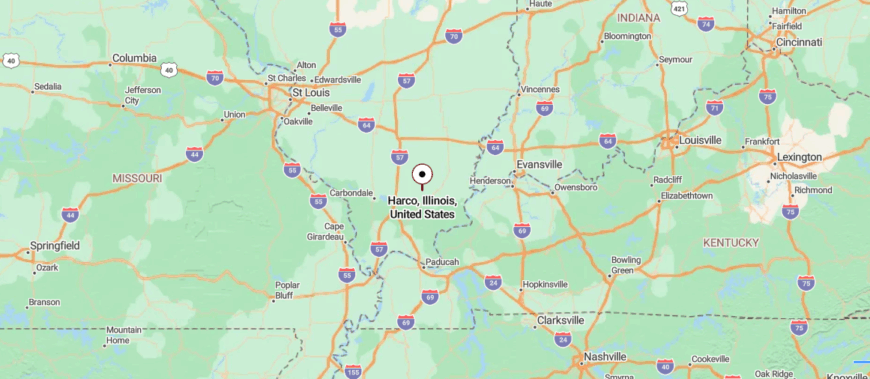
Ledford is an unincorporated community in Saline County, tucked into the gently rolling terrain of southern Illinois near the broad Saline River valley. It sits about 3 miles west of Harrisburg and roughly 30 miles north of Carbondale, set quietly off local county roads amid farmland and wooded hollows.
You reach Ledford by following two‑lane rural highways that wind past cropland, groves of trees, and mellow ridge lines before narrowing into peaceful country lanes leading into the small settlement. It’s close enough for an easy country drive, but distant enough that the rustle of leaves and the lingering quiet of the land feel like time itself has slowed its pace around you.
20. Peters Creek’s Basin Refuge
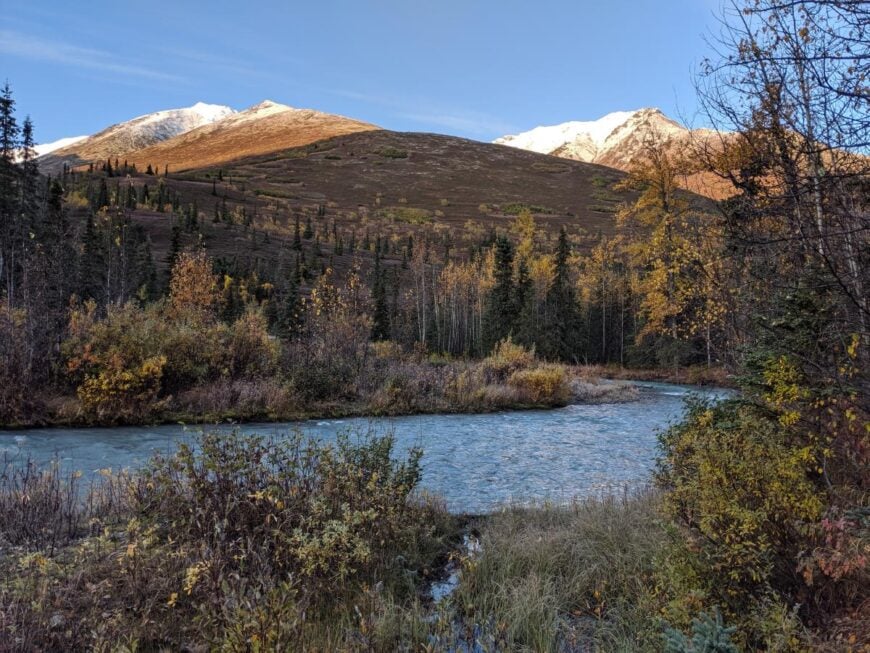
Peters Creek is nestled deep in the wooded hills of southern Illinois, where narrow roads wind through the Shawnee and the trees seem to fold in around you. With no major highways nearby and only a handful of homes scattered along the creek, it feels entirely removed from the pace of modern life.
The quiet here is thick—broken only by birdsong, the rush of water over stone, and the distant bark of a farm dog. Visitors might hike the forest trails, wade in the shallows of the creek, explore old homesteads softened by moss, or simply sit beneath sycamores and watch the day pass slowly.
There are no shops, no stoplights—just land, water, and the few who call it home. Most residents live close to the land, farming small plots or enjoying retirement surrounded by trees. Peters Creek feels like a secret held by the forest. It’s the kind of place that reminds you how deeply stillness can settle in.
Where is Peters Creek?
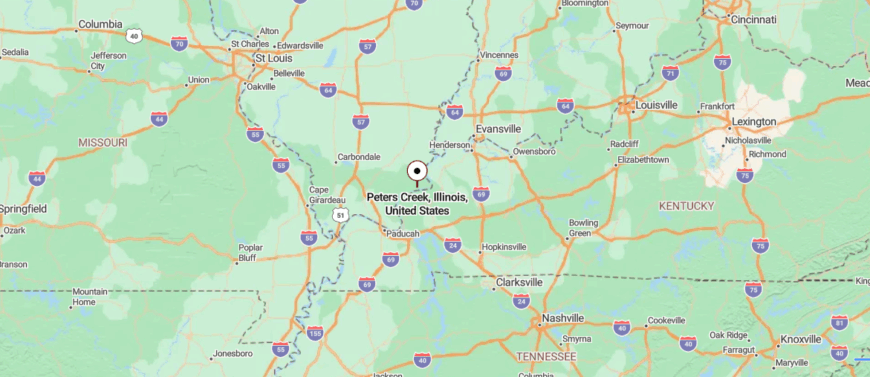
Peters Creek is located in Hardin County, tucked into the southeastern corner of Illinois beside the banks of the Ohio River in a lightly wooded, rural stretch of the state. It lies approximately 4 miles northeast of Elizabethtown and about 4½ miles west of Cave‑in‑Rock, quietly reached via Illinois Route 146 through farmland and woodlands.
You arrive by following the two‑lane state highway as it winds past river bottom farms and patches of oak woodland, then turn onto quieter country lanes that ease into the small community clustered near the stream it’s named for. It’s close enough to reach by an easy drive, but secluded enough that the hush of the river valley and the whisper of wooded ridges feel like a secret kept by the land itself.
19. Chenoa’s Route‑Crossed Calm
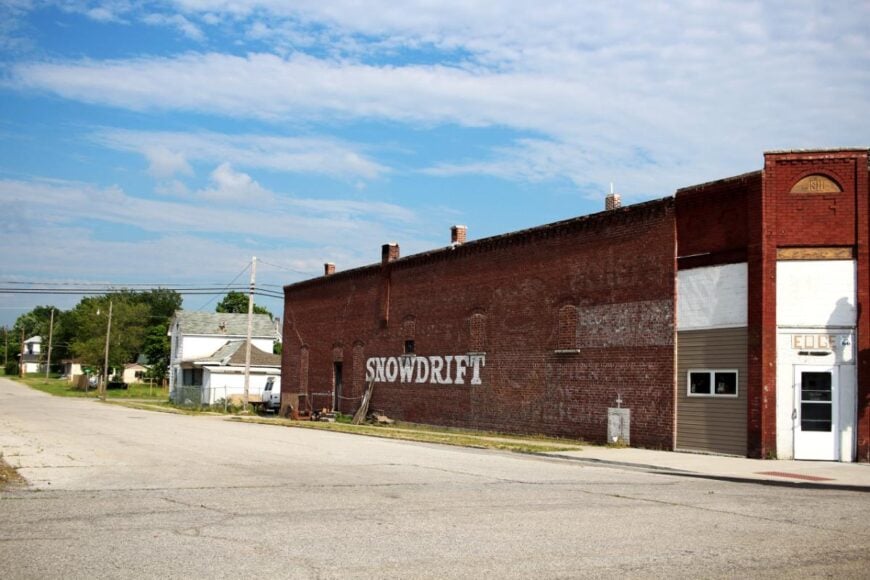
Chenoa rests quietly where two old rail lines cross in the flat heart of central Illinois, surrounded by endless farmland and skies that stretch without interruption. Though technically connected by country highways, the town still feels distant—its pace unbothered by the rush of nearby interstates.
With just a few thousand residents, it holds a grounded, rural calm where grain elevators tower over quiet streets and the scent of tilled earth carries through open windows. You can stroll through the small town square, catch a local baseball game, stop into the family-run diner, or take a slow drive down county roads lined with corn.
Farming remains the center of life here, its rhythm guiding everything from school calendars to Sunday gatherings. Chenoa doesn’t try to impress—it simply stays steady, rooted in land and routine. It’s the kind of place that reminds you how peaceful ordinary can feel.
Where is Chenoa?
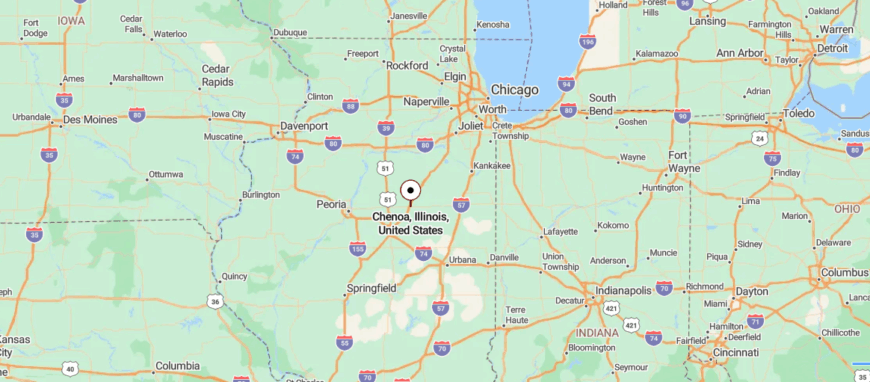
Chenoa is located in McLean County, positioned in central Illinois where rich farmland meets the gentle rise of the prairie, just south of the village of Lexington. It lies about 110 miles southwest of Chicago and sits at the crossroads of Interstate 55, Historic Route 66, and U.S. Route 24, offering a quiet stop in a wide expanse of agricultural fields.
You enter Chenoa by exiting I‑55 or Route 24 and following rolling two‑lane roads through endless corn and soybean fields before arriving at its small downtown, still marked by historic architecture and open sky. It’s close enough to reach with ease, but far enough that the prairie stillness and historic small‑town calm wrap around you like a gentle pause in time.
18. Ozark’s Forest Echo
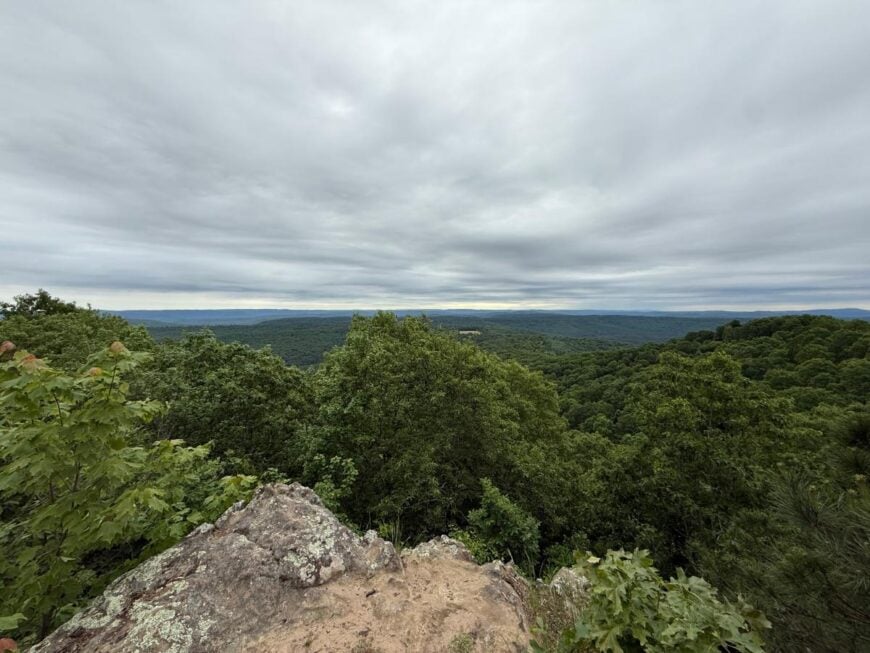
Ozark is hidden deep within the Shawnee National Forest, where winding backroads and thick canopies of oak and hickory make the town feel almost like a forest secret. With no major highways nearby and only a scattering of homes, it’s the kind of place you don’t stumble upon—you seek it out.
The land feels ancient and undisturbed, with moss-covered trails, sandstone outcroppings, and the steady hush of the woods. Visitors hike the River to River Trail, explore the nearby Bell Smith Springs, paddle along creeks, or camp beneath the stars in near-total silence.
There are no shops or town square—just forest, trails, and the occasional plume of woodsmoke rising between trees. Most who live here do so quietly, off the land or in connection with nearby conservation work. It’s the kind of place that reminds you how truly hidden peace can be.
Where is Ozark?
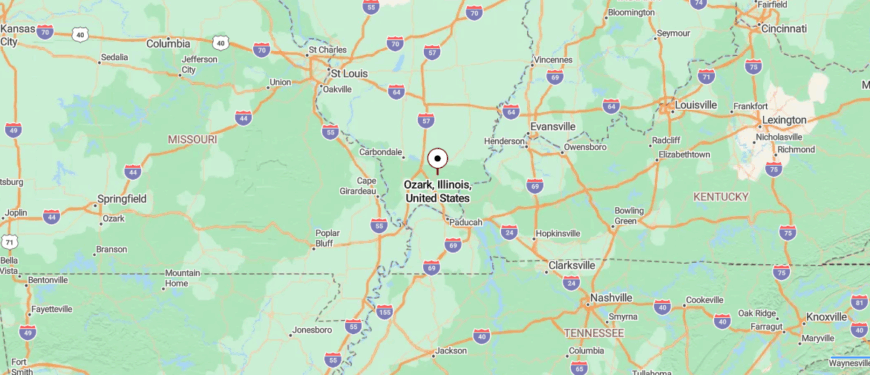
Ozark is an unincorporated community in Johnson County, tucked into the deep southern region of Illinois within the narrow Illinois Ozark uplift near the banks of Brushy or Blackburn Creek. It lies about 4 miles south of New Burnside and roughly 15 miles west of Vienna, quietly set off local country roads well south of major highways.
You reach it by driving along two‑lane rural routes through rolling fields and wooded hollows, eventually turning onto quieter lanes that lead into its small cluster of homes and Camp Ondessonk grounds. It’s close enough to reach without planning, but secluded enough that the forested ridges and soft murmur of creekside woods make the place feel like a quiet retreat held by the land itself.
17. Buncombe’s Forest‑Edged Whisper
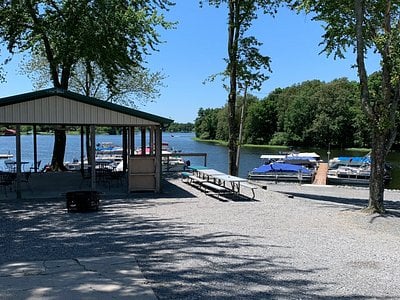
Buncombe sits quietly in the rolling hills of southern Illinois, surrounded by farmland, forest, and the low hum of rural life that rarely makes a sound beyond the breeze. With fewer than 200 residents and no major roads nearby, the town feels gently folded into the land—unseen unless you’re looking for it.
Time moves slowly here, marked by the rhythm of tractors, the scent of fresh-cut hay, and the rustle of trees along gravel roads. Visitors can hike the nearby trails of Ferne Clyffe State Park, fish in still ponds, stop by a roadside produce stand, or take a slow country drive beneath wide skies.
Farming remains the heartbeat of Buncombe, with generations rooted in its soil and its quiet way of life. There are no bright lights or busy corners—just stillness and space. It’s the kind of place that reminds you how good it feels to disappear for a while.
Where is Buncombe?
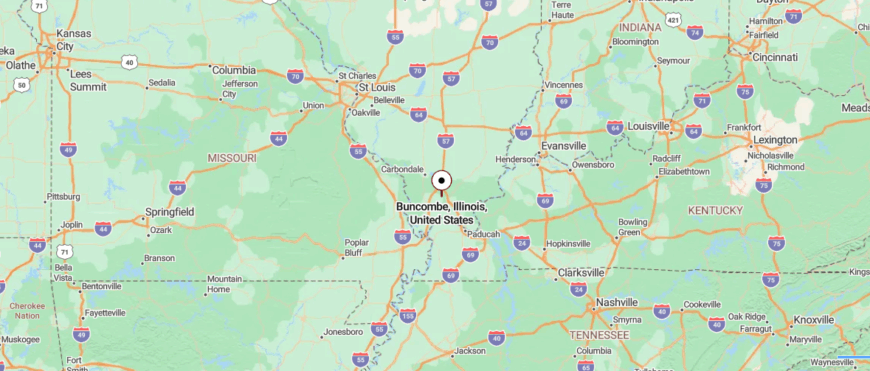
Buncombe is located in western Johnson County, tucked into southern Illinois where gentle farmland and wooded hollows extend toward the Ohio and Mississippi River lowlands. It lies about 6 miles from Goreville to the north and roughly 8 miles from Vienna to the southeast, quietly set off Illinois Route 37 amid a landscape shaped by fields and modest ridgelines.
The approach follows two‑lane rural highways through open fields and tree-lined stretches before turning onto narrower county roads that ease you into the small village of fewer than 210 residents. It’s close enough to reach without effort, but secluded enough that the breeze through cornfields and the hush of distant forest seem to settle time around its quiet streets.
16. Pulaski’s Heartland Stillness
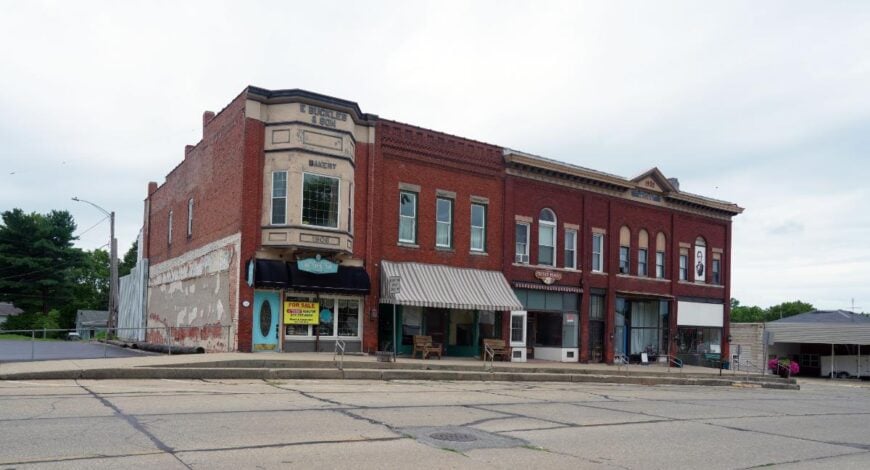
Pulaski lies quietly in the southern tip of Illinois, where flat fields meet wooded lowlands and the roads seem to stretch endlessly without interruption. With fewer than 200 residents and no major highways nearby, the town feels deeply tucked away—surrounded by farmland, creeks, and the slow rhythm of rural life.
Its stillness is felt in the empty sidewalks, the faded storefronts, and the rustling of leaves through overgrown yards. Visitors can fish in nearby Cache River wetlands, explore Civil War-era cemeteries, drive scenic farm roads, or sit under the old trees that line quiet backstreets.
Farming still supports many who live here, along with small-town trades and deep local roots. Pulaski doesn’t try to be noticed—it just endures, steady and undisturbed. It’s the kind of place that reminds you how time can settle in and stay.
Where is Pulaski?
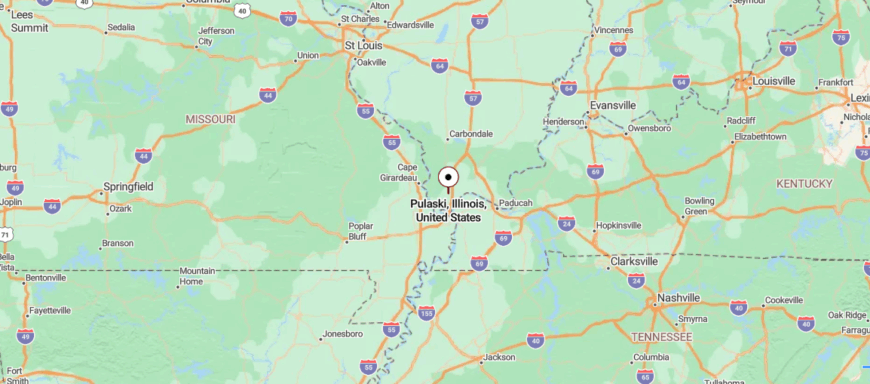
Pulaski is located in Pulaski County, tucked into the far southern tip of Illinois along the gentle floodplain of the Ohio River. It lies about 8 miles south of Mounds and roughly 15 miles west of the Mississippi River, quietly set off Illinois Route 37 amid bottomland farmland and wooded wetlands.
You reach it via two-lane rural highways that wind through open fields and low terraces before turning onto quieter county lanes shaded by oak groves and bayous on the final stretch into town. It’s close enough for a calm day trip, but secluded enough that the soft murmur of the river and the hush of wooded wetlands feel like a quiet retreat held by the land itself.
15. Tamms’s Vanishing Quiet
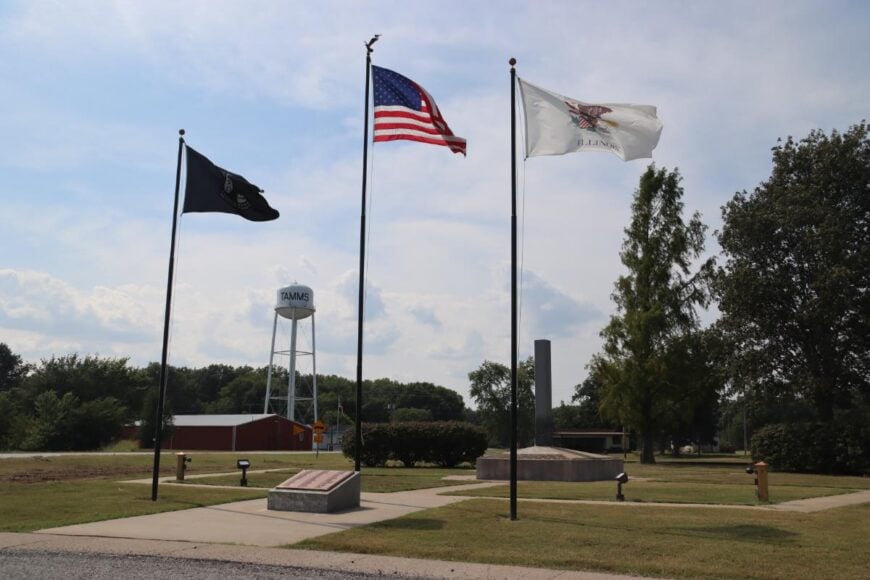
Tamms sits quietly in the far southern reaches of Illinois, surrounded by dense woods, lowland swamps, and miles of quiet farmland that seem to mute the rest of the world. Tucked far from interstates and with a population under 500, the town feels deeply isolated—shaped more by the land than by any sense of urgency.
Old buildings and narrow roads reflect a place that once moved faster, but now leans fully into stillness. Visitors can explore the nearby Cache River wetlands, hike trails shaded by towering cypress trees, fish in remote ponds, or drive past the remnants of old homesteads swallowed by nature.
Most locals work in agriculture or commute to nearby towns, holding tight to familiar routines and generational ties. Tamms moves slowly, deliberately, like the marsh waters that edge its southern boundary. It’s the kind of place that reminds you how isolation can feel like home.
Where is Tamms?
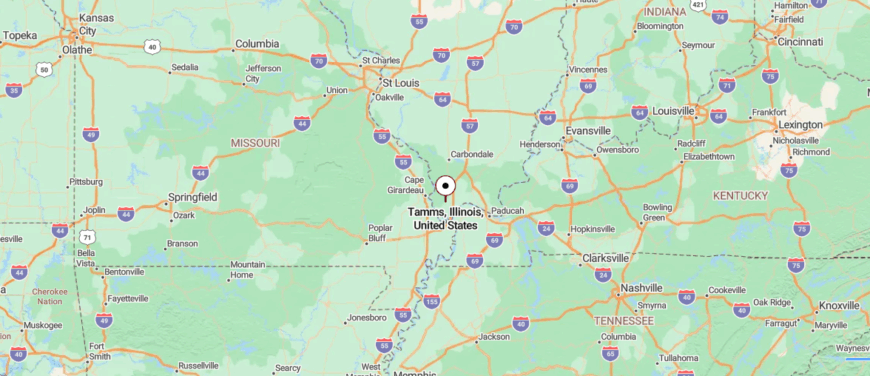
Tamms is located in Alexander County, nestled in the deep southern tip of Illinois near the Mississippi River floodplain, where farmland gives way to wetlands and wooded bottomlands. It lies about 10 miles southeast of Cairo and around 25 miles west of Carbondale, quietly set off Illinois Route 127 amid open fields and dense swales.
You reach the village via two‑lane rural highways that meander through fields dotted with corn and soy, then turn onto quieter county roads that wind into Tamms’s small cluster of homes beneath towering trees. It’s close enough to reach on a slow afternoon drive, but secluded enough that the soft rustle of the floodplain woods and the wide silence of open fields feel like a sanctuary larger than the village itself.
14. Belknap’s Pastoral Retreat
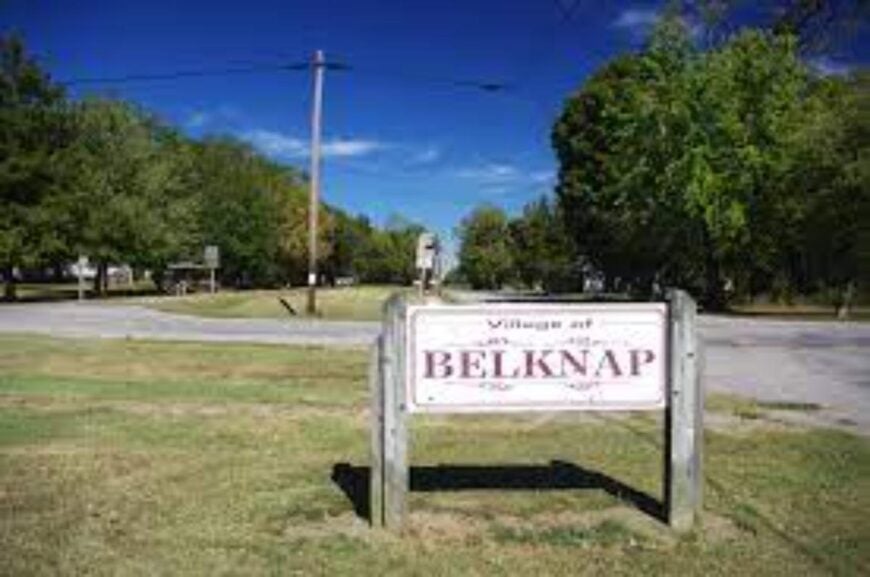
Belknap is nestled at the edge of the Cache River wetlands in deep southern Illinois, where forest, water, and farmland blend into a quiet world far removed from the rest. With no major highways nearby and a population barely topping 100, the village feels entirely tucked away—surrounded by cypress swamps, low-lying trails, and the kind of silence that settles in like mist.
The town’s rhythm is slow and earthy, with old houses set back from gravel roads and wildlife often seen before people. Visitors can hike the Tunnel Hill State Trail, kayak through ancient water trails in the Heron Pond Preserve, or bike shaded paths lined with wildflowers and birdsong.
There are no stores or crowds—just nature, stillness, and the occasional passing train. Those who live here are tied to the land or nearby conservation work, embracing the solitude most wouldn’t notice unless they stopped. It’s the kind of place that reminds you how hidden beauty thrives where few think to look.
Where is Belknap?
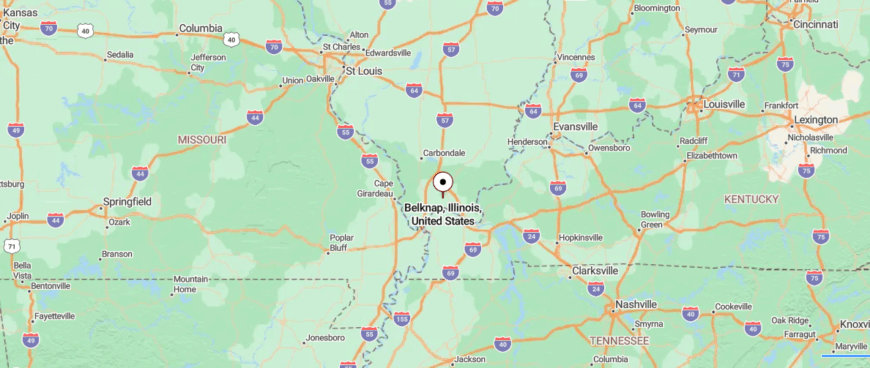
Belknap is located in Johnson County, tucked into the far southern tier of Illinois within the Cache River basin amid low-lying wetlands and wooded bottomlands. It sits about 6 miles south of Vienna and roughly 90 miles east of Cape Girardeau (across the Mississippi), quietly set off county roads near Heron Pond – Little Black Slough Nature Preserve. `
You reach the village by following Illinois Route 37 and then turning onto narrow rural lanes that pass through dense wetlands, stands of cypress, and open fields before arriving at its small cluster of homes. It’s close enough to find without effort, but secluded enough that the landscape seems to breathe in the hush of nature’s stillness around you.
13. Simpson’s Hill‑Wrapped Solitude
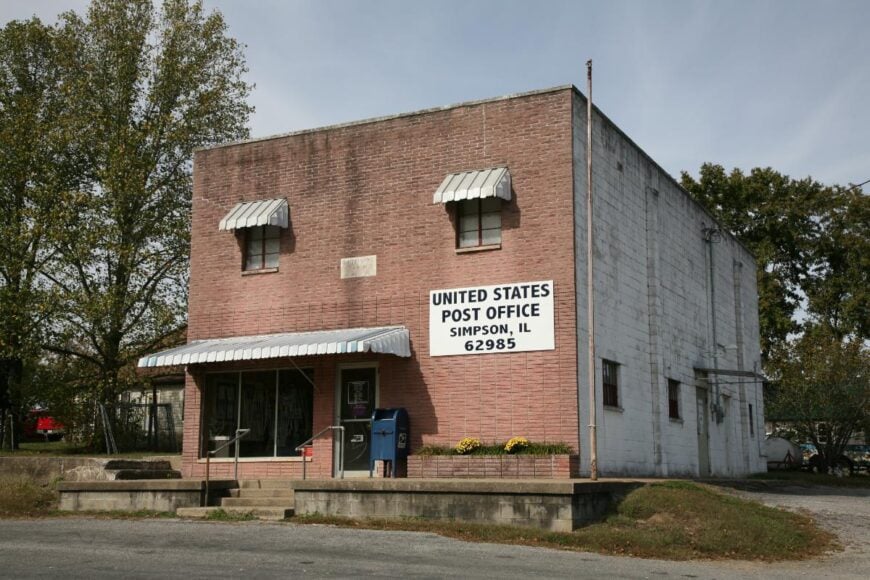
Simpson is tucked deep within the forested hills of southern Illinois, where winding roads, thick tree cover, and rocky outcrops make it feel almost entirely off the map. With fewer than 70 residents and no major highways nearby, it exists in near-complete stillness—surrounded by the vast Shawnee National Forest and hidden from view by the land itself.
The village is quiet and rustic, with scattered homes, gravel drives, and the soft soundtrack of wind in the trees and creek water slipping over stone. Visitors can hike the nearby River to River Trail, explore the wild beauty of Bell Smith Springs, or picnic beside hidden waterfalls under a canopy of green.
There’s no commerce here—just nature and a handful of people who’ve chosen to live where the forest is thick and the pace is slow. Most residents farm, work in nearby towns, or simply live in sync with the land. It’s the kind of place that reminds you how remote can also mean rooted.
Where is Simpson?
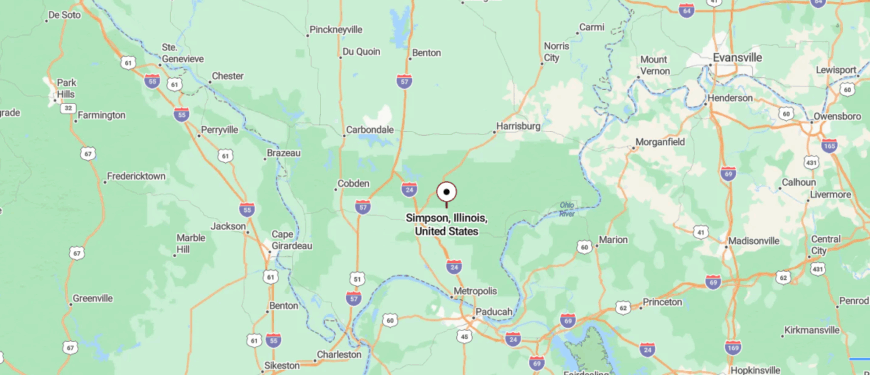
Simpson is located in Johnson County, tucked into the far southern corner of Illinois where gently rolling farmland meets the woodlands of the Cache River basin. It sits around 8 miles west of Vienna and approximately 12 miles east of Goreville, quietly set off Illinois Route 37 before dipping onto county roads into its tucked‑away valley.
The drive follows two‑lane rural routes through open fields and pockets of woods, eventually narrowing into peaceful lanes that guide you into the small community. It’s close enough for an easy afternoon drive, but distant and private enough that the air and landscape seem to settle into a deeper quiet as you arrive.
12. Karnak’s Cypress-Fringed Stillness
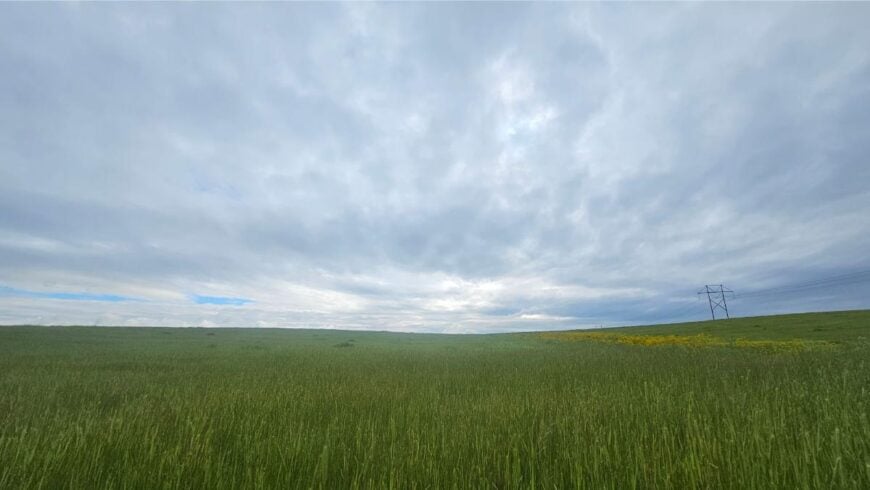
Karnak lies at the edge of the Cache River wetlands in southern Illinois, where the land flattens into marshes, forests, and winding backroads that seem to lead nowhere fast. With fewer than 500 residents and no major highways nearby, the town feels gently cut off—surrounded by nature and shaped by stillness.
Its atmosphere is earthy and unhurried, with modest homes, weathered porches, and the distant call of herons echoing through the trees. Visitors can bike or hike the Tunnel Hill State Trail, paddle through ancient cypress groves, explore the wetlands boardwalk, or spot wildlife along the Cache River.
Most locals are tied to farming, conservation work, or nearby small-town jobs, living close to the rhythms of land and water. Karnak moves quietly, like the slow rivers that surround it. It’s the kind of place that reminds you how peace can grow where the road narrows and the forest deepens.
Where is Karnak?
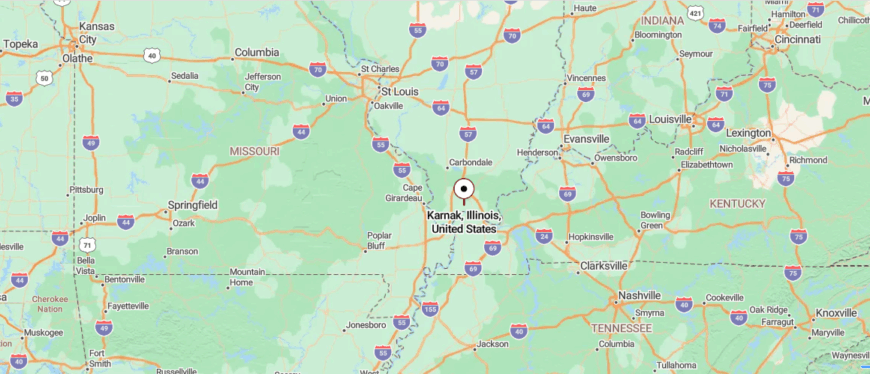
Karnak is located in Pulaski County, tucked into the deep southern tip of Illinois along the edge of the Mississippi River’s floodplain and the Shawnee National Forest. It sits about 10 miles southeast of Mounds and roughly 25 miles east of Cairo, quietly set off narrow county roads rather than major highways.
To reach the village, you head south from U.S. Route 51 or Illinois Route 37 onto quiet rural lanes that weave through wooded wetlands and past sparse homesteads before arriving in Karnak. It’s close enough for a thoughtful day trip, but remote enough that the hush of forest and river valley seems to wrap the land in a tranquil solitude.
11. Stonefort’s Trailside Peace
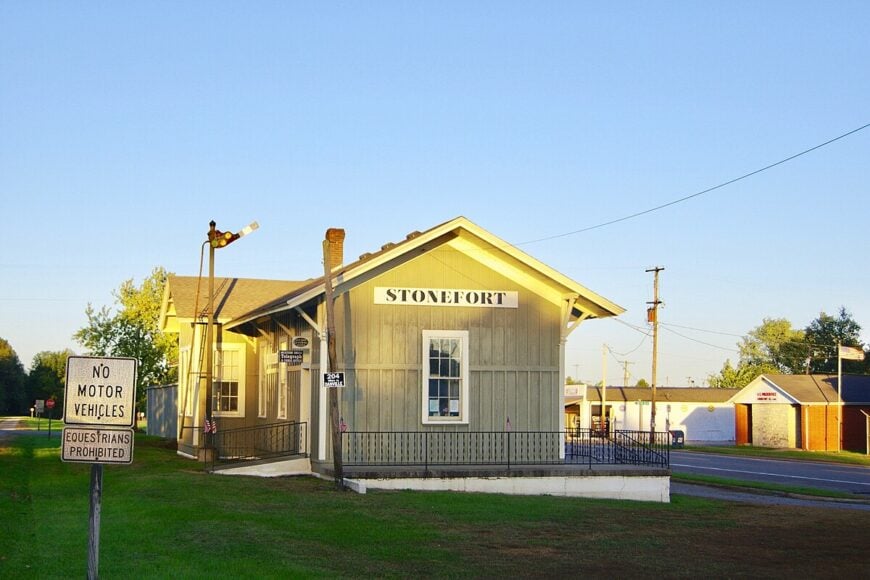
Stonefort sits high on a ridge at the edge of the Shawnee National Forest, where forested hills and deep-cut valleys keep it gently hidden from the outside world. With a population of just a few hundred and no major highways passing through, the town feels quietly perched—surrounded by rock bluffs, winding roads, and the hush of wooded land.
Its name echoes in the landscape, where stone foundations and crumbling walls hint at a rich, rugged past. Visitors can hike the Tunnel Hill State Trail, explore scenic overlooks, bike through forest corridors, or picnic near the remains of old stone structures.
Farming and tourism still tie people to the land, but most who live here stay for the stillness. Stonefort moves slowly, its quiet broken only by wind and birdsong. It’s the kind of place that reminds you how history and solitude can live side by side.
Where is Stonefort?
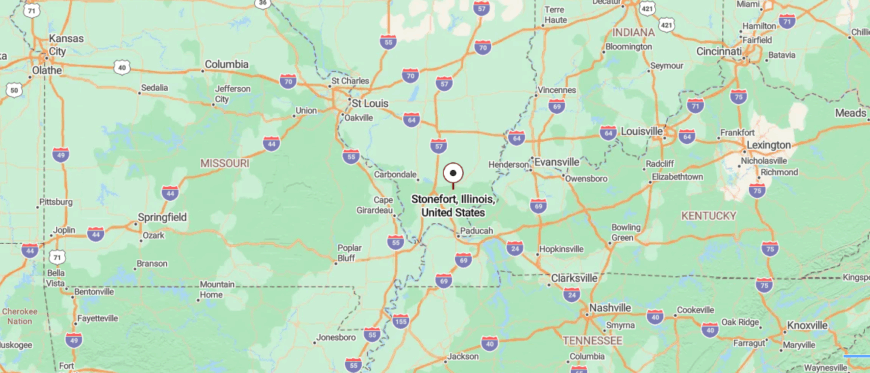
Stonefort is located in the southern tip of Illinois, nestled in Williamson County where the rugged uplands of Shawnee National Forest meet the broad valley of the Big Muddy River. It sits about 12 miles west of Carrier Mills and roughly 20 miles north of the Ohio River corridor, quietly set off Illinois Route 34 amid rolling forested hills and open glades.
You reach Stonefort via two‑lane country roads that wind through wooded hollows and past limestone outcrops before easing into the town’s shaded, small‑town center. It’s close enough to visit on a peaceful drive, but secluded enough that the hush of forest canopy and distant ridge lines make the place feel like a hidden edge of wildness.
10. Karnak: A Quiet Village Amidst the Wildlife Refuges

Karnak, a quaint village with a population of just over 500 residents, offers a peaceful retreat surrounded by lush wetlands and rich biodiversity. Outdoor enthusiasts can explore the nearby Cache River State Natural Area, where kayaking through ancient cypress swamps and hiking along scenic trails reveal a world of natural wonders. The village’s primary industries revolve around agriculture and conservation, reflecting its deep connection to the land. Karnak’s seclusion is accentuated by its serene environment, free from the noise of city life, making it an ideal spot for those seeking solace in nature. The slow-paced lifestyle and close-knit community add to its charm, offering a glimpse into a simpler way of living.
Where is Karnak?
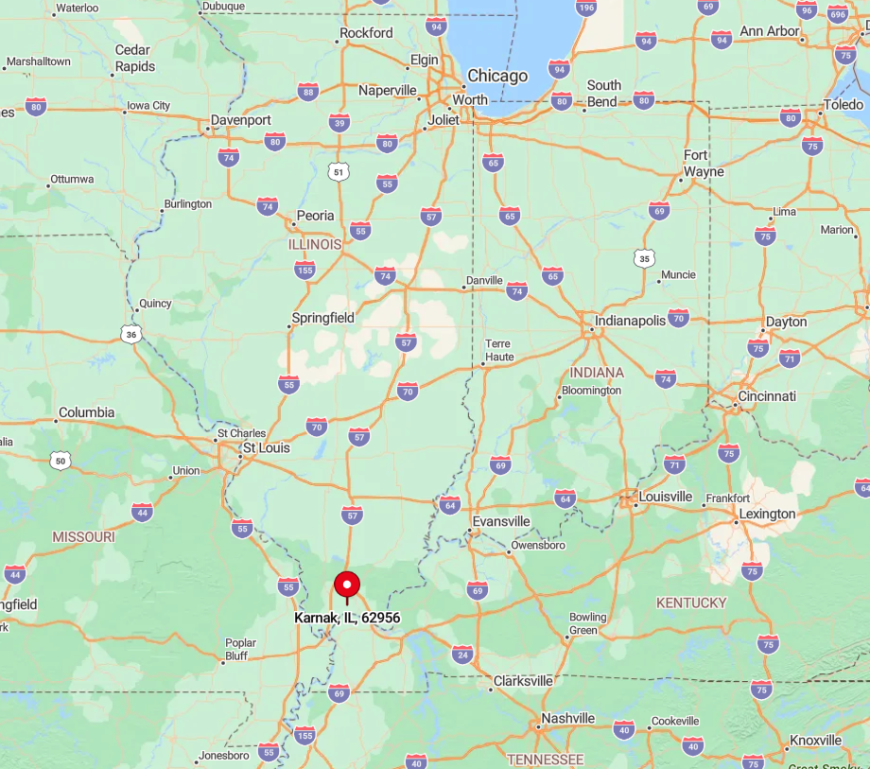
Located in Pulaski County at the southern tip of Illinois, Karnak sits near the confluence of the Ohio and Mississippi Rivers. Its remote setting amidst the expansive Cache River wetlands contributes to its secluded atmosphere. Accessing Karnak involves a journey through picturesque rural roads, primarily via Illinois Route 169, enhancing the feeling of escape from the urban grind. The village’s proximity to protected natural areas ensures it remains a tranquil haven, tucked away in the heart of the Shawnee Hills.
9. Equality: Discovering Historic Salt Springs and Ghost Tales

Equality is a small town with approximately 600 inhabitants, steeped in history and local legends. Visitors can explore the remnants of the salt mining industry that once thrived here, including the historic Gallatin Salines. The town is also known for the Old Slave House (Hickory Hill), a site rich with ghost stories and tales from the past, although it is currently closed to the public. The primary industries today are agriculture and tourism, drawing those interested in its storied past. Equality’s secluded nature is evident in its quiet streets and untouched landscapes, providing a serene environment away from the crowds.
Where is Equality?

Nestled in Gallatin County, Equality is situated in southeastern Illinois, surrounded by rolling hills and dense forests. Its seclusion is partly due to its distance from major highways, making it a peaceful retreat for history buffs and nature lovers alike. The town can be reached via Illinois Route 13 and 142, leading travelers through scenic routes that enhance its hidden gem status. Equality’s off-the-beaten-path location preserves its tranquil atmosphere, offering a step back in time amidst the Shawnee Hills.
8. Eddyville: Gateway to Shawnee’s Hidden Trails
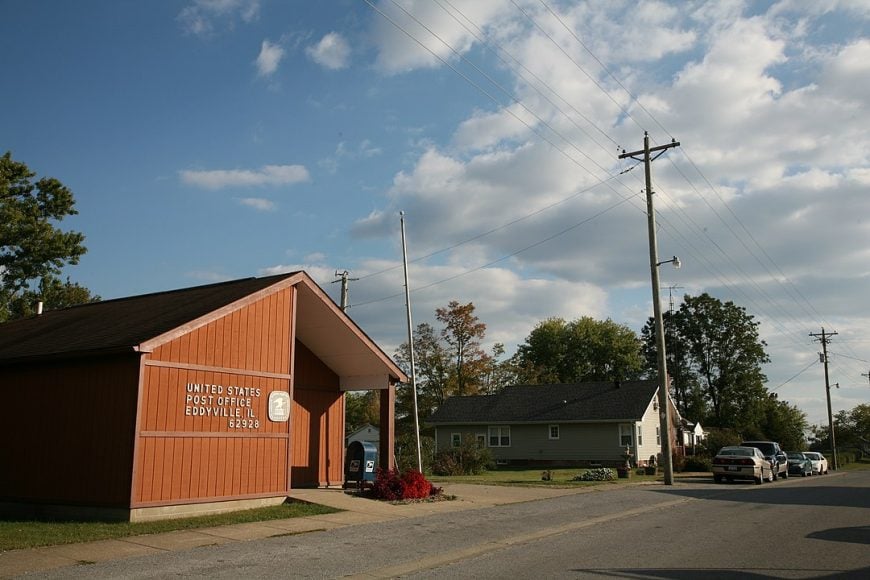
Eddyville, with a population of around 100, is truly a gateway to adventure within the Shawnee National Forest. This tiny village is surrounded by some of the most secluded hiking trails, majestic waterfalls like Burden Falls, and natural wonders such as Bell Smith Springs. The area caters to outdoor enthusiasts, offering horseback riding, camping, and endless exploration opportunities. The mainstay industries are tourism and recreation services, supporting those who come to experience the untouched beauty. Eddyville’s seclusion is characterized by its deep immersion in nature, far removed from urban development.
Where is Eddyville?
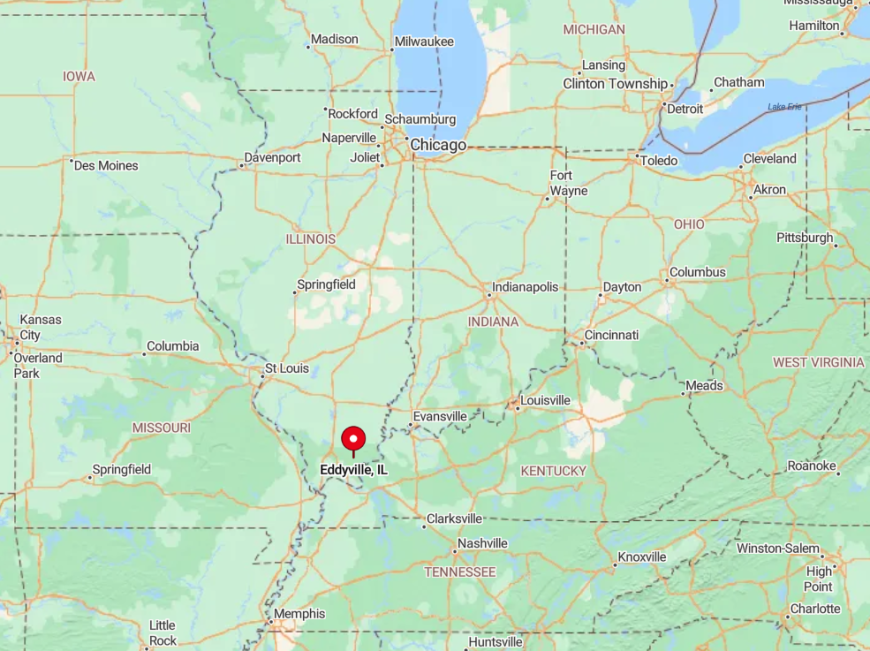
Located in Pope County in Southern Illinois, Eddyville is enveloped by the sprawling expanses of the Shawnee National Forest. Its remote location is underscored by the absence of major roadways, accessible primarily via Route 145. This isolation ensures that the village remains a peaceful enclave, with the surrounding forest acting as a natural barrier from the outside world. Getting to Eddyville is an adventure in itself, promising serenity upon arrival.
7. Rosiclare: The Fluorspar Capital with a Rich Mining Heritage

Rosiclare, home to about 1,100 residents, is known for its historical significance in fluorspar mining. Once dubbed the “Fluorspar Capital of the World,” the town now offers a glimpse into its mining past with the American Fluorite Museum. Nestled along the Ohio River, visitors can enjoy riverfront parks, fishing, and the charm of a small riverside community. While mining has diminished, the town’s economy leans on tourism and local services. Rosiclare’s secluded nature comes from its riverside location and the surrounding rolling hills, providing a peaceful ambiance.
Where is Rosiclare?
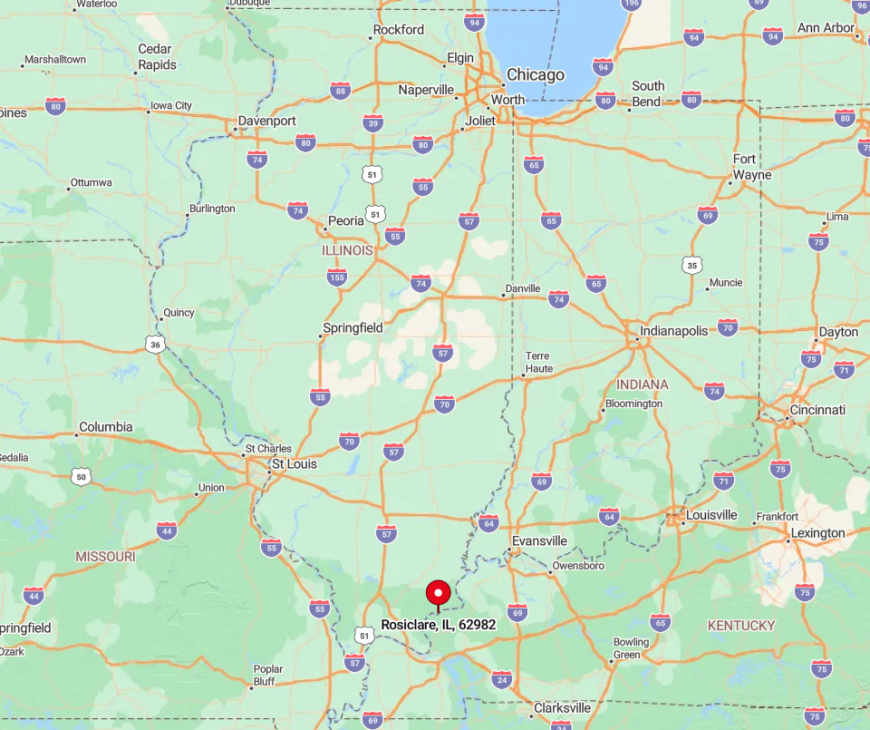
Situated in Hardin County, Rosiclare lies along the banks of the Ohio River in southeastern Illinois. Its remote setting is accentuated by winding roads and rural landscapes, reachable via Illinois Route 146. The town’s position along the river and away from major urban centers contributes to its serene environment. Visitors often find the journey to Rosiclare as captivating as the destination, with scenic views enhancing its secluded reputation.
6. Cave-in-Rock: Adventure and Mystery along the Riverbank
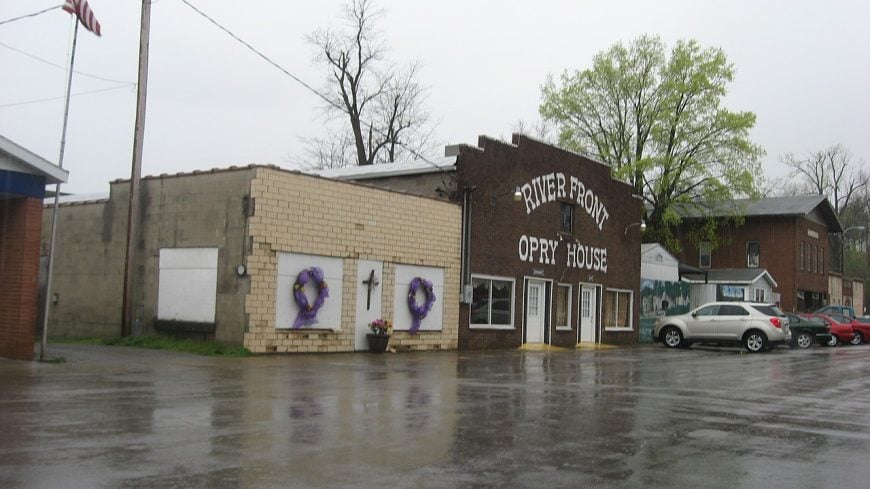
Cave-in-Rock, a village of about 300 people, is famous for the large cave that shares its name, steeped in legends of river pirates and outlaws. The town offers adventurous activities like exploring the Cave-In-Rock State Park, hiking, and enjoying panoramic views of the Ohio River. The local economy revolves around tourism, drawing visitors intrigued by its mysterious past and natural beauty. Its seclusion is accentuated by the quiet streets and the expansive wilderness that surrounds it, offering an escape into adventure and history.
Where is Cave-in-Rock?

Located in Hardin County on the banks of the Ohio River, Cave-in-Rock sits at the southeastern edge of Illinois. Its remote position is emphasized by its limited accessibility, with Illinois Route 1 being the primary road leading into town. The village’s isolation is furthered by the vast forests and river that border it, making it a hidden treasure for those willing to venture off the main highways. Access by ferry from Kentucky adds to its unique charm and sense of seclusion.
5. Elizabethtown: A Quaint Riverside Hamlet Steeped in History

Elizabethtown, with a population nearing 300, is a quaint village known for its rich history and charming riverside setting. It is home to the Rose Hotel, the oldest operating hotel in Illinois, offering guests a nostalgic experience of bygone eras. Visitors can enjoy leisurely activities like fishing along the Ohio River or strolling through historic sites. The main industries include tourism and local commerce, supporting the tight-knit community. Its secluded nature comes from its small size and the serene backdrop of the river, providing a peaceful retreat.
Where is Elizabethtown?
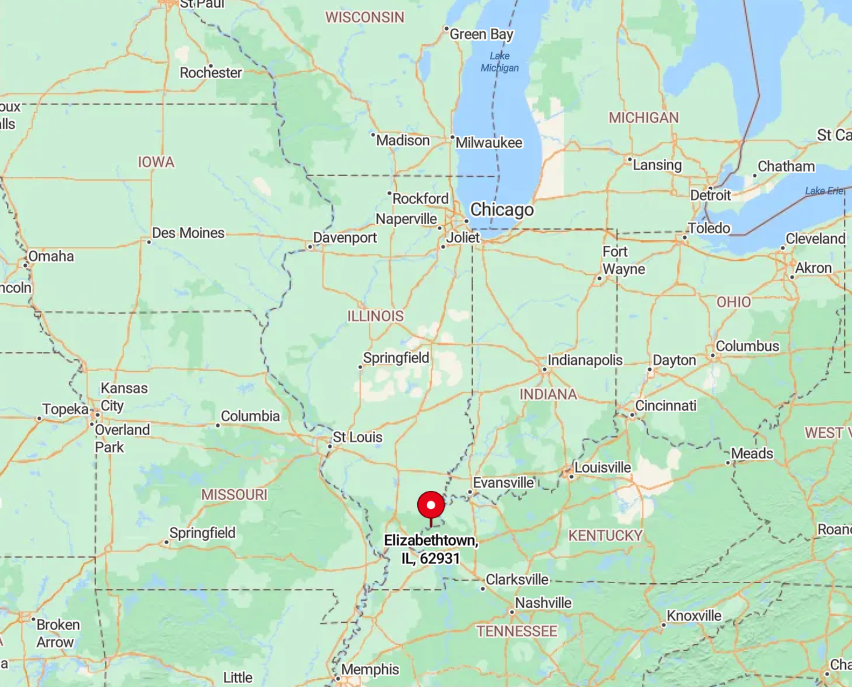
Perched on the banks of the Ohio River in Hardin County, Elizabethtown is tucked away in southeastern Illinois. The village is accessible via Illinois Route 146, which meanders through rolling hills and forested areas. Its remote location and the surrounding natural beauty contribute to its sense of solitude. The tranquil river views and slow pace of life make it an ideal spot for those seeking a quiet escape.
4. Golconda: Riverside Serenity on the Ohio River
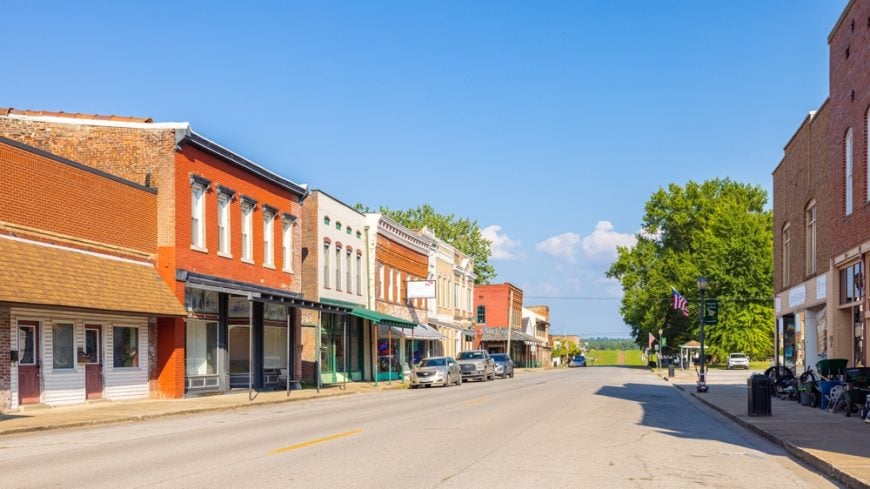
Golconda is a historic town of about 650 residents, offering picturesque streets lined with well-preserved 19th-century buildings. It serves as a gateway to the beauty of the Ohio River, where visitors can enjoy boating, fishing, and riverside parks. The town hosts events like the annual Deer Festival, reflecting its community spirit. Primary industries are tourism and small-scale agriculture, maintaining its rural charm. Golconda’s seclusion is due to its riverside locale and the enveloping Shawnee National Forest, providing a serene environment steeped in history.
Where is Golconda?
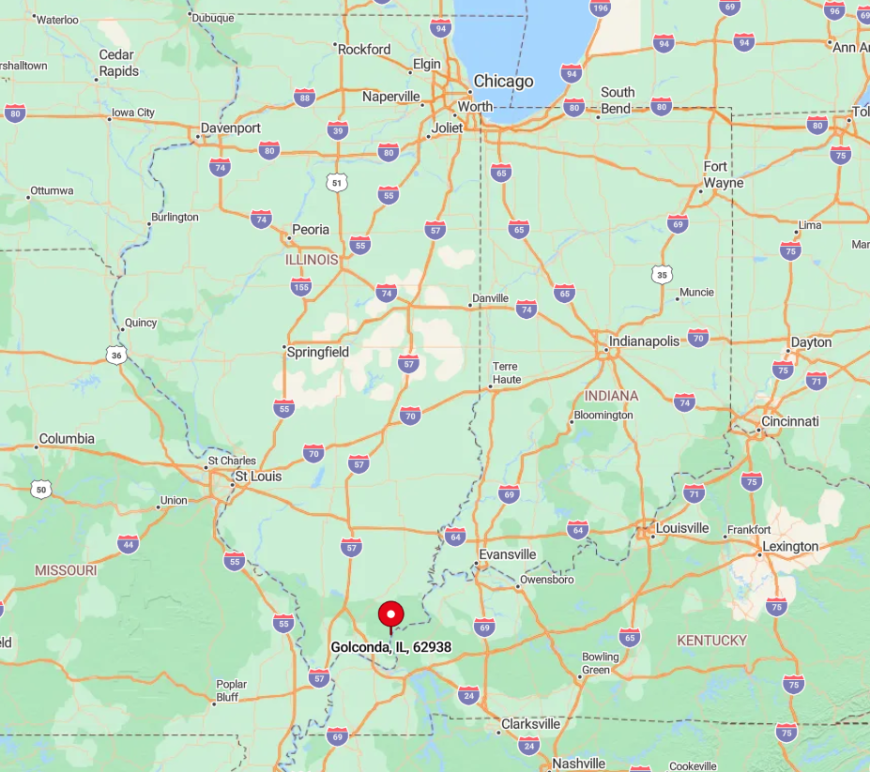
Located in Pope County, Golconda sits along the Ohio River in southeastern Illinois. Its remoteness is accentuated by its distance from major cities, accessible via Illinois Route 146. The town is surrounded by vast forests and the river, enhancing its tranquil atmosphere. The journey to Golconda offers scenic views that highlight its secluded position within the Shawnee Hills.
3. Alto Pass: Scenic Views and Historic Charm atop the Hills
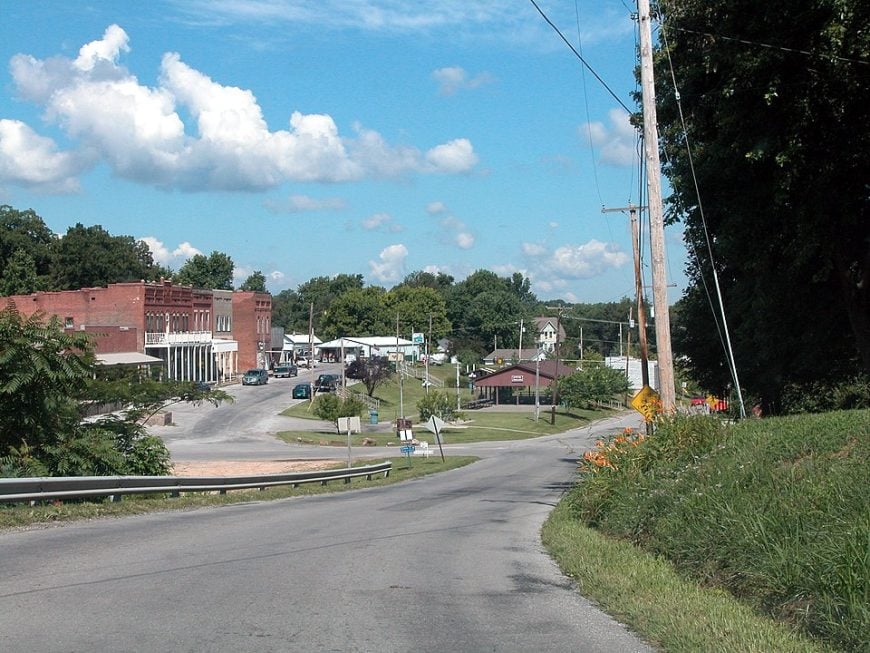
Alto Pass, with a population of around 390, is perched atop the Shawnee Hills, offering breathtaking vistas of the surrounding orchards and vineyards. Visitors can explore the historic Bald Knob Cross, which provides panoramic views and a serene setting. The town is part of the Shawnee Hills Wine Trail, featuring local wineries that showcase the region’s winemaking heritage. Agriculture and tourism are the main industries, fostering a community that appreciates nature and tradition. Alto Pass’s seclusion comes from its elevated position and rural surroundings, making it a peaceful retreat.
Where is Alto Pass?

Situated in Union County in Southern Illinois, Alto Pass is accessible via Illinois Route 127. Its location atop the hills contributes to its sense of isolation, surrounded by forests and farmland. The winding roads leading to the town offer stunning views, enhancing the feeling of escaping into the countryside. Alto Pass’s scenic beauty and quiet atmosphere make it a hidden gem within the Shawnee Hills.
2. Cobden: A Taste of Southern Illinois Wine Country
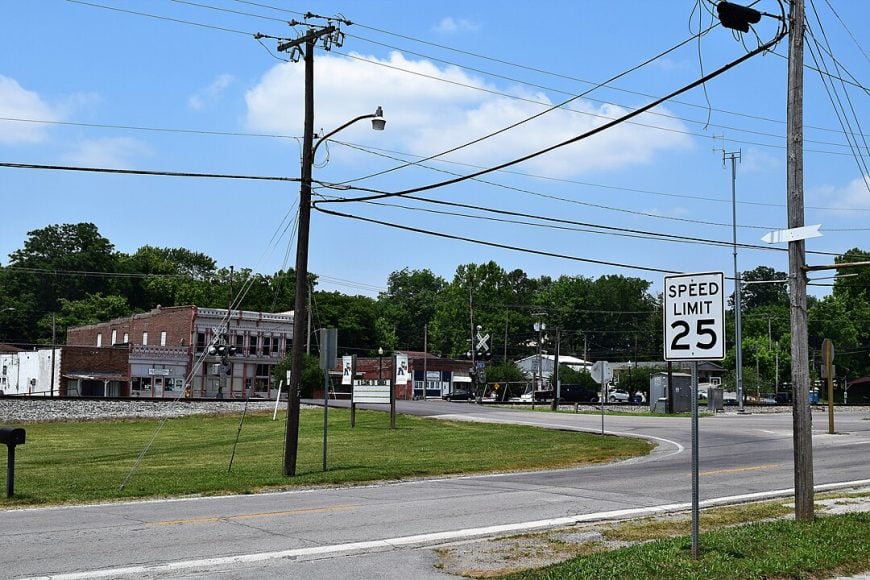
Cobden is a charming village of about 1,100 residents, nestled in the heart of Southern Illinois wine country. It’s known for its rich agricultural heritage, producing fruits like apples and peaches that you can enjoy at local orchards. The town features unique boutiques, art galleries, and hosts events like the annual Peach Festival. Agriculture and viticulture are central to the economy, reflecting the community’s connection to the land. Cobden’s secluded nature is highlighted by its rural setting and the rolling hills that surround it, offering a quaint and peaceful atmosphere.
Where is Cobden?
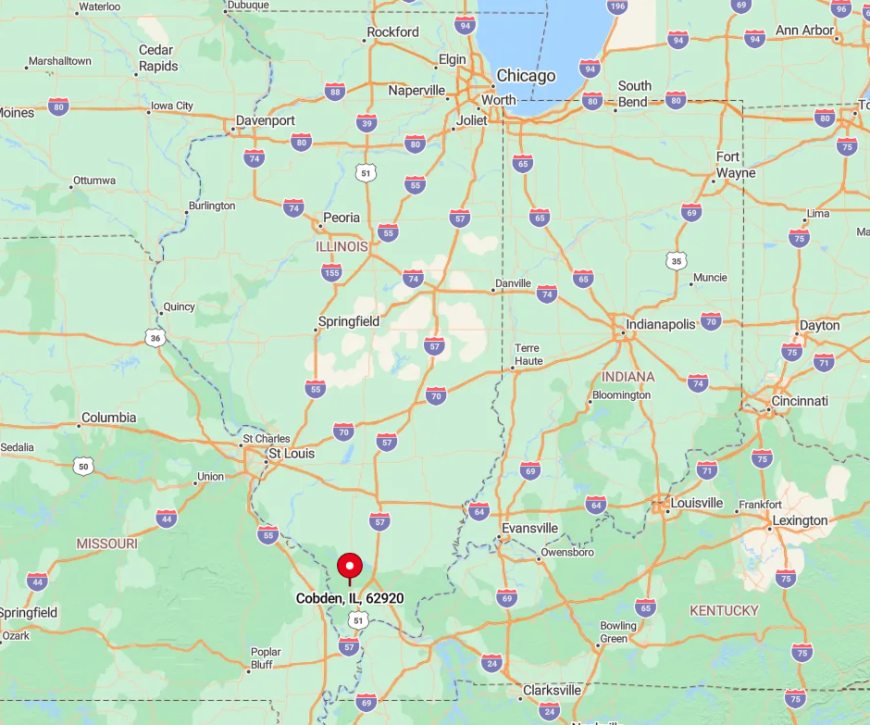
Located in Union County, Cobden lies along Illinois Route 51, south of Carbondale. Its seclusion is due to its position amidst vast farmland and vineyards, away from the hustle of larger towns. The scenic route into Cobden takes you through picturesque landscapes that emphasize its hidden nature. The village’s tranquil environment provides a warm welcome to those seeking a slower pace of life.
1. Makanda: The Hidden Artistic Village Nestled in the Forest
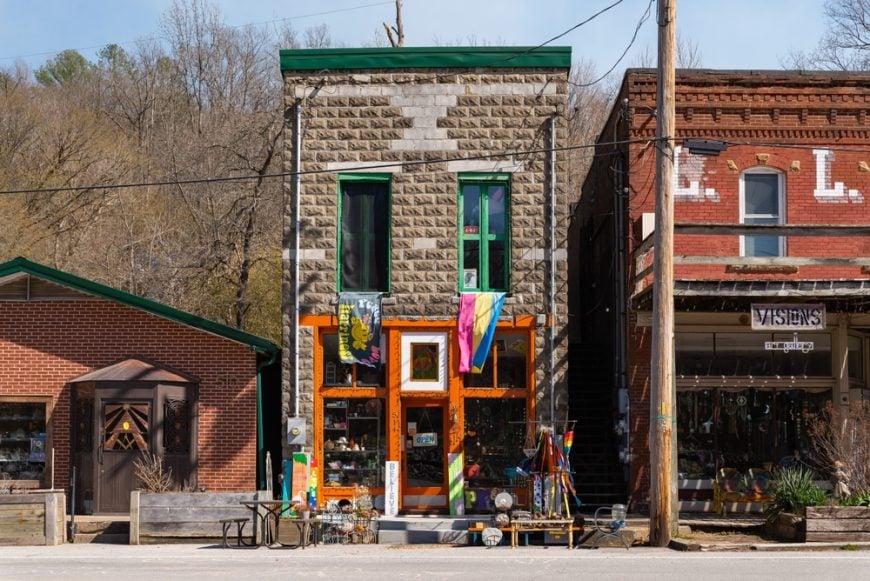
Makanda, often referred to as the “Heart of the Shawnee Forest,” is a tiny village with a population of around 600. It boasts a vibrant artistic community, with its downtown boardwalk featuring eclectic art galleries and unique boutiques. Surrounded by the natural beauty of Giant City State Park, visitors can enjoy hiking, rock climbing, and observing wildlife. The local economy thrives on art, tourism, and small businesses that reflect the town’s creative spirit. Makanda’s seclusion is amplified by its lush forest surroundings, offering an enchanting escape into nature and creativity.
Where is Makanda?
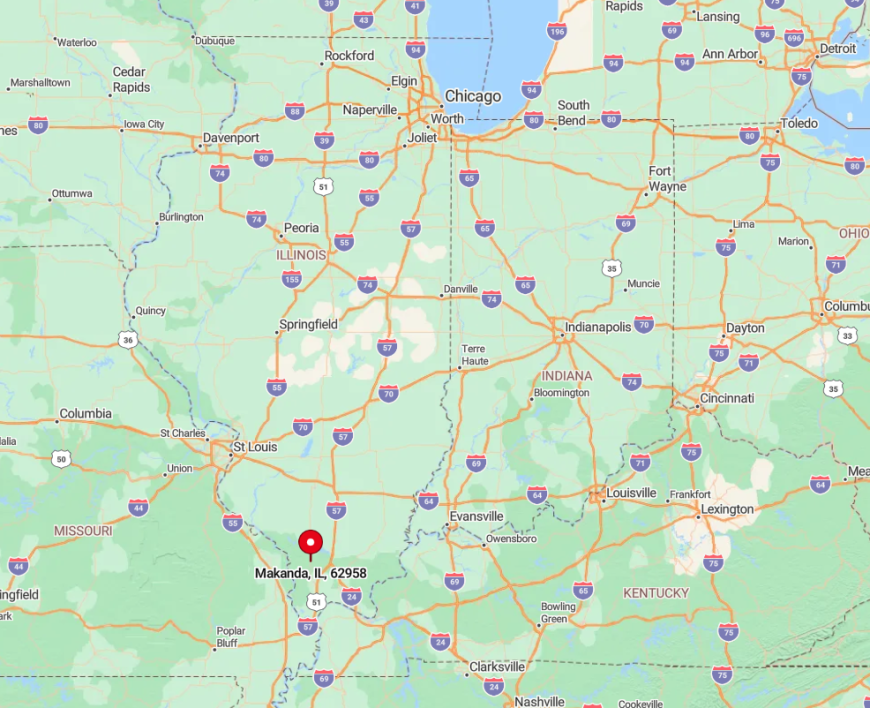
Nestled in Jackson County, Makanda is accessible via Makanda Road off U.S. Route 51, south of Carbondale. The village is enveloped by the Shawnee National Forest, which enhances its secluded ambiance. The winding roads leading into Makanda pass through dense forests and rolling hills, making the journey as delightful as the destination. Its tucked-away location ensures it remains a serene haven for artists and nature lovers alike.
